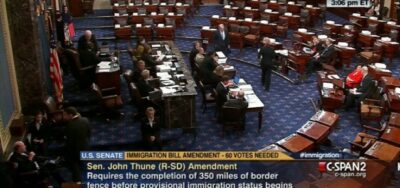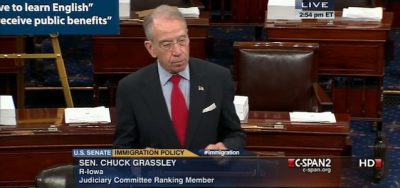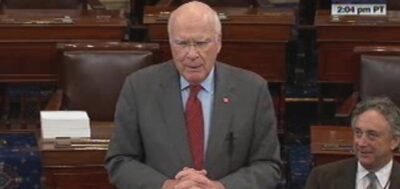Legislation

Is a Border Surge the Only Way to Pass Immigration Reform and Ensure Legalization?
During the second full week of debate on S. 744, momentum towards passage increased with a positive CBO score, the defeat of several poison-pill amendments, and the announcement of a Republican border amendment that is thought to bring ten to fifteen Republicans to “yes” on final passage. A series of critical cloture votes is likely to be filed over the next few days, paving the way for a final vote next Friday. Despite this news, the mood is not jubilant, as good policy seems to be losing to pragmatic politics. Read More

The Power of Reform: CBO Report Quantifies the Economic Benefits of the Senate Immigration Bill
According to the Congressional Budget Office (CBO) and Joint Committee on Taxation (JCT), the fiscal and economic effects of the Senate immigration reform bill (S. 744) would be overwhelmingly positive. If enacted, the bill would help reduce the federal budget deficit by approximately $1 trillion over 20 years, would boost the U.S. economy as whole without negatively affecting U.S. workers, and would greatly reduce future undocumented immigration. These are the conclusions laid out in three reports released in June and July 2013. On June 18, the CBO issued two reports on the version of S. 744 that was reported out of the Senate Judiciary Committee on May 28. The first one analyzes (or “scores”) the fiscal impact of the bill over the next 20 years and the second one focuses on the impact that some aspects of the bill would have on the U.S. economy. On July 3, the CBO issued a revised score on the version of the bill that passed the Senate on June 27. This version includes the Corker-Hoeven “border surge” amendment, which calls for a significant increase in border-enforcement spending. What is a CBO score and what are its main implications? Nearly every bill that is approved by a full committee of either house of Congress is subject to a formal cost estimate by the CBO. The report produced as a result of this analysis is known as the CBO “score.” The purpose of this analysis is to aid in economic and budgetary decisions on a wide assortment of programs covered by the federal budget. In general, the CBO estimates what the net fiscal impact of a bill would be, considering both the costs and the benefits associated with its implementation. Read More

CBO Gives High Marks to Senate Immigration Bill
Yesterday, the Congressional Budget Office (CBO) released its much-anticipated “scoring,” or cost estimate, of the Senate immigration bill. Overall, the numbers are good. Very good. The CBO projects 20 years ahead and predicts fiscal savings in the amount of roughly $1 trillion. In addition, the CBO explained in a separate report that the bill would have a host of economic benefits that are not captured in a strictly fiscal analysis, such as GDP growth, increased productivity, and long-term wage increases. Read More

Crafting a Successful Legalization Program: Lessons From the Past
One of the themes that emerged from the Senate Judiciary Committee mark up of the 2013 Senate immigration bill was the necessity of avoiding the mistakes of the past. In the context of legalization for the 11 million unauthorized immigrants now in the United States, the argument is often made that the 1986 law wasn’t tough enough, and any new legalization program should have more requirements and restrictions. However, in my 39-year career with the Department of Homeland Security (DHS) and former Immigration and Naturalization Service (INS), and after years of studying implementation of the 1986 law, I’ve reached a different conclusion. A successful legalization program depends on simplicity and common sense. There are many lessons to be learned from the 1986 law about how to design a better legalization program. Fortunately, many of those lessons have been absorbed by the drafters of S. 744, the Border Security, Economic Opportunity and Immigration Modernization Act. Nonetheless, as the debate continues on this bill, it is important to reiterate the importance of good design and thoughtful implementation. That is what will ensure success and provide the country with a working immigration system. Read More

How the Senate Votes On Amendments
The Senate voted on four amendments to the immigration reform bill today, starting the ball rolling on what is likely to be a series of amendment votes over the next few days. The Senate rejected two votes requiring more enforcement at the border as a condition of implementing or completing a legalization program: Vitter 1228, which failed 36-58, and Thune 1197, which failed 39-54. Two other amendments were less divisive: Tester 1198, adding tribal governments to the Border Task Force, which passed 94-0 and Landrieu 1222, an adoption measure, which passed on a voice vote. In each case, in order to be adopted, a sixty vote threshold was required, rather than a simple majority, which has become the norm in the Senate. Needless to say, the variety of votes and rules can be confusing, leading to the need for some background on the amendment process. Read More

Happy Birthday DACA!
A year ago, President Obama announced the DACA program from the steps of the White House Rose Garden. The announcement marked a victory for thousands of undocumented immigrant youth whose courage and activism inspired the Administration to take action. Since that day, over half a million young immigrants have come forward under DACA to seek relief from deportation and to secure work authorization. Read More

House Immigration Bill Promotes Old Model Immigration Solutions
Today the House held a hearing on H.R. 2278, the "Strengthen and Fortify Enforcement Act" (the SAFE Act), which is designed, as its name suggests, to be a lopsided, enforcement-only bill that imposes additional criminal penalties, border security, and detention and deportation, while encouraging discredited policies such as self-deportation and state interference with immigration law. Instead of these old enforcement-only policies, which do not work, what is needed is a comprehensive solution that fixes our broken legal immigration system and provides a path to earned legalization. Read More

Border Security Amendments To Delay Legalization Harm Immigration Bill Efforts
During The first full day of debate after the Senate approved a motion to proceed to S. 744, the Border Security, Economic Opportunity, and Immigration Modernization Act, several Senators sought to make the debate all about border security. In the process, they proposed amendments that tie border security increases to the start of the legalization program in ways that make legalization a virtually unattainable goal. One of these amendments is from Sen. John Cornyn (R-TX). His RESULTS amendment ties the fate of unauthorized immigrants who are already living in the United States, and who have applied for legalization, to the success of highly stringent border-enforcement measures in deterring future unauthorized immigration. However, applicants for legalization have no control over the ability of the federal government to maintain the integrity of U.S. borders, so there is no logical reason to link their legal status to border-enforcement metrics. The RESULTS amendment also mistakenly views immigration reform as a two-step process: enforcement, followed by legalization. However, the various components of immigration reform must be implemented simultaneously to maximize their effectiveness. The amendment breaks apart what should by a single, integrated revamping of U.S. immigration policy. Finally, the RESULTS amendment contains no mechanism for judging the feasibility or cost-effectiveness of the border-security measures and metrics that it would mandate. Read More

Senate Overwhelmingly Approves Motion To Proceed To Immigration Bill
S. 744, the Gang of Eight’s immigration reform bill, cleared another significant hurdle today when the Senate approved a motion to proceed to the legislation. The motion to proceed passed overwhelmingly by a vote of 84-15. Read More

Procedural Path Of The Senate Immigration Bill
The Senate immigration reform debate has officially begun. Senate Majority Leader Harry Reid (D-NV) filed cloture on the motion to proceed Thursday on S. 744, the “Border Security, Economic Opportunity, and Immigration Modernization Act,” the first step to having the full Senate debate the measure after the Senate Judiciary Committee approved it a few weeks ago. Senators started to make their cases for and against the bill during floor speeches on Friday. On Tuesday, the Senate will vote to end debate on the motion to proceed to the immigration bill at 2:15 p.m. Tuesday and then vote to proceed at 4 p.m. Read More
Make a contribution
Make a direct impact on the lives of immigrants.
